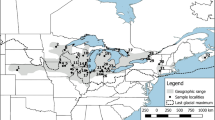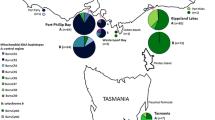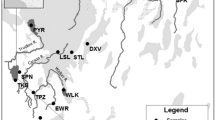Abstract
Blanding’s turtle is a North American freshwater turtle whose main range occurs south of the Great Lakes; disjunct populations occur east of the Appalachian Mountains from New York to Nova Scotia. The species is listed as threatened or endangered in most of its range. We employed five variable microsatellites to examine samples of 300 individuals in 12 populations. Estimates of F ST based on pairwise comparisons of populations ranged from 0.000 to 0.465. Phylogenetic analysis of these F ST values reveals that the Appalachian Mountains and the Hudson River appear to present major barriers to gene flow in Blanding’s turtle. The extent of fine-scale genetic structure previously reported in the Nova Scotian populations was not found in other parts of the species’ range. We recommend that populations separated by the Appalachian Mountains as well as the highly disjunct Nova Scotian populations of Blanding’s turtle be recognized as evolutionarily significant units.
Similar content being viewed by others
References
Avery HW, Vitt LJ (1984) How to get blood from a turtle. Copeia 209–210
Balloux F, Goudet J (2002) Statistical properties of population differentiation estimators under stepwise mutation in a finite island model. Mol Ecol 11:771–783
Balloux J, Lugon-Moulin N (2002) The estimation of population differentiation with microsatellite markers. Mol Ecol 11:155–165
Bleakney JS (1958) A zoogeographic study of the amphibians and reptiles of eastern Canada. Natl Mus Can Bull 155:1–119
Bury RB, Germano DJ (2003) Differences in habitat use by Blanding’s turtles, Emydoidea blandingii, and painted turtles, Chrysemys picta, in the Nebraska sandhills. Am Midl Nat 149:241–244
Congdon JD, Gibbons JW (1996) Structure and dynamics of a turtle community over two decades. In: Cody ML, Smallwood JA (eds) Long-term studies of vertebrate communities. Academic Press, San Diego, USA, pp 137–159
Congdon JD, Dunham AE, van Loben Sels RC (1993) Delayed sexual maturity and demographics of Blanding’s Turtles (Emydoidea blandingii): implications for conservation and management of long-lived organisms. Conserv Biol 7:826–833
Congdon JD, Nagel RD, Kinney OM, van Loben Sels RC (2001) Hypotheses of aging in a long-lived vertebrate, Blanding’s Turtle (Emydoidea blandingii). Exp Gerontol 36:813–827
Crandall KA, Bininda-Emonds ORP, Mace GM, Wayne RK (2000) Considering evolutionary processes in conservation biology. TREE 15:290–295
Excoffier L, Smouse PE, Quattro JM (1992) Analysis of molecular variance inferred from metric distances among DNA haplotypes: applications to human mitochondrial DNA. Genetics 131:479–491
FitzSimmons NN (1997) Male marine turtles: gene flow, philopatry and mating systems of the green turtle Chelonia mydas. PhD Thesis, University of Queensland, Australia
Fraser DJ, Bernatchez L (2001) Adaptive evolutionary conservation: towards a unified concept for defining conservation units. Mol Ecol 10:2741–2752
Goudet J (2001) FSTAT, a program to estimate and test gene diversities and fixation indices (version 2.9.3). Available from http://www.unil.ch/izea/softwares/fstat.html. Updated from Goudet (1995)
Hall CD, Cuthbert FJ (2000) Impact of a controlled wetland drawdown on Blanding’s turtles in Minnesota. Chelonian Conserv Biol 3:643–649
Haskell A, Pokras MA (1994) Nonlethal blood and muscle tissue collection from redbelly turtles for genetic studies. Herpetol Rev 25:11–12
Herman TB (1997) Life on the edge: managing peripheral populations in a changing landscape. In: Van Abbema J (ed) Proceedings: Conservation, restoration, and management of tortoises and turtles – An International Conference. NY Turtle and Tortoise Society, pp 372–376
Herman TB, Power TD, Eaton BR (1995) Status of Blanding’s Turtles (Emydoidea blandingii) in Nova Scotia, Canada. Can Field Nat 109:182–191
Herman TB, Boates JS, Drysdale C, Eaton S, McNeil J, Mockford SW, Alcorn E, Bleakney S, Elderkin M, Gilhen J, Jones C, Kierstead J, Mills J, Morrison I, O’Grady S, Smith D (in press) National recovery plan for the Blanding’s Turtle (Emydoidea blandingii) Nova Scotia population. Nova Scotia, Canada
Jowett T (1986) Preparation of nucleic acids. In: Roberts DB (ed) Drosophila: a practical approach. IRL Press, Oxford, pp 275–285
Joyal LA, McCollough M, Hunter ML (2001) Landscape ecology approaches to weland species conservation: A case study of two turtle species in Southern Maine. Conserv Biol 15:1755–1762
Kiviat E (1997) Blanding’s turtle habitat requirements and implications for conservation in Dutchess County, New York. In: Van Abbema J (ed) Proceedings: Conservation, restoration, and management of tortoises and turtles – An International Conference, NY Turtle and Tortoise Society, pp 377–382
Kuo C-H, Janzen FJ (2004) Genetic effects of a persistent bottleneck on a natural population of ornate box turtles (Terrapin ornate). Conserv Genet 5:425–438
Manni F, Geurard E, Heyer E (2004) Geographic patterns of (genetic, morphologic, linguistic) variation: how barriers can be detected by “Monmonier’s algorithm”. Hum Biol 76:173–190
McCollough M (1997) Status and conservation of turtles in Maine. In: Tyning TF (ed) Status and conservation of turtles of the Northeastern United States. Serpent’s Tale, Lanesboro, Minnesota, pp 7–11
McCoy CJ (1973) Emydoidea E. blandingii. Catalog Am Amphib Reptile 136:1–4
McNeil J (2002) Distribution, movements, morphology and reproduction in a population of Blanding’s turtle (Emydoidea blandingii) in an unprotected landscape in Southwestern Nova Scotia. MSc Thesis, Acadia University, Wolfville, Nova Scotia, Canada
Miller M (1997) Tools for population genetic analysis (TFPGA): a windows program for the analysis of allozyme and molecular population genetic data. Computer software distributed by author
Mockford SW, McEachern L, Herman TB, Snyder M, Wright JM (2005) Population genetic structure of a disjunct population of Blanding’s turtle (Emydoidea blandingii) in Nova Scotia, Canada. Biol Conserv 123:373–380
Monmonier M (1973) Maximum-difference barriers: an alternative numerical regionalization method. Geogr Anal 3:245–261
Moritz C (1994) Defining “Evolutionary Significant Units” for conservation. TREE 9:373–375
Moritz C (2002) Strategies to protect biological diversity and the evolutionary processes that sustain it. Syst Biol 51:238–254
Nei M (1987) Molecular evolutionary genetics. Columbia University Press, New York
Osentoski MF (2001) Population genetic structure and male reproductive success of a Blanding’s turtle (Emydoidea blandingii) population in Southeastern Michigan. PhD Thesis, University of Miami, Coral Gables, Florida, USA
Osentoski MF, Mockford S, Wright JM, Snyder M, Herman TB, Hughes CR (2002) Isolation and characterization of microsatellite loci from the Blanding’s turtle, Emydoidea blandingii. Mol Ecol Notes 2:147–149
Pappas MJ, Brecke BJ, Congdon JD (2000) The Blanding’s turtles (Emydoidea blandingii) of Weaver Dunes Minnesota. Chelonian Conserv Biol 3:557–568
Parris DC, Daeschler E (1995) Pleistocene turtles of Port Kennedy cave (late Irvingtonian), Montgomery County, Pennsylvania. J Paleontol 69:563–568
Piepgras S, Sajwaj T, Hamernick M, Lang JW (1998) Blanding’s turtle (Emydoidea blandingii) in the Brainerd/Baxter region: population status, distribution and management recommendations. Final report to the Nongame Wildlife Office, Minnesota DNR, Brainerd
Piepgras SA, Lang JW (2000) Spatial ecology of Blanding’s turtle in central Minnesota. Chelonian Conserv Biol 3:589–601
Power TD (1989) Seasonal movements and nesting ecology of a relict population of Blanding’s turtle (Emydoidea blandingii (Holbrook)) in Nova Scotia. MSc Thesis, Acadia University, Wolfville, Nova Scotia, Canada
Pritchard JK, Stephens M, Donnelly P (2000) Inference of population structure using multilocus genotype data. Genetics 155:945–959
Raymond M, Rousset F (1995a) Genepop (version 1.2): population genetics software for exact tests and ecumenicism. J Hered 86:248–249
Raymond M, Rousset F (1995b) An exact test for population differentiation. Evolution 49:1280–1283
Ross DA, Anderson RK (1990) Habitat use, movements and nesting of Emydoidea blandingii in central Wisconsin. J Herpetol 24:6–12
Rousset F (1997) Genetic differentiation and estimation of gene flow from F-statistics under isolation by distance. Genetics 145:1219–1228
Rowe JW, Moll EO (1991) A radiotelemetric study of activity and movements of the Blanding’s turtle Emydoidea blandingii in Northeastern Illinois USA. J Herpetol 25:178–185
Rubin CS, Warner RE Ludwig DR (2001a) Habitat use and movements of radiotagged Blanding’s turtles (Emydoidea blandingii) in a suburban ladscape. Chelonian Conserv Biol 4:136–141
Rubin CS, Warner RE, Bouzat JL, Paige KN (2001b) Population genetic structure of Blanding’s turtles (Emydoidea blandingii) in an urban landscape. Biol Conserv 99:323–330
Sajwaj TD, Piepgras SA, Lang JW (1998) Blanding’s turtle (Emydoidea blandingii) at Camp Ripley: critical habitats, population status and management guidelines. Final report to the Nongame Wildlife office, Minnesota Department of Natural Resourses, Brainerd, Minnesota
Sambrook J, Fitsch EF, Maniatis T (1989) Molecular cloning: a laboratory manual, 2nd edn. Cold Spring Harbor Laboratory Press, New York
Schmidt KP (1938) Herpetological evidence for the postglacial eastward expansion of the steppe in North America. Ecology 19:396–407
Schneider S, Kueffer J, Roessli D, Excoffier L (1997) Arlequin ver. 1.1: a software for population genetic analysis. Genetics and Biometry Laboratory, University of Geneva, Switzerland
Sites JW, FitzSimmons NN, da Silva NJ, Cantarelli VH (1999) Conservation genetics of the giant Amazon River Turtle (Podocnemis expansa): inferences from two classes of molecular markers. Chelonian Conserv Biol 3:454–463
Smith PW (1957) An analysis of post-Wisconsin biogeography of the prairie peninsula region based on distributional phenomena among terrestrial vertebrate populations. Ecology 38:205–218
Taylor BL, Dizon AE (1999) First policy then science: why a management unit based solely on genetic criteria cannot work. Mol Ecol 8:S11–S16
Underhill JC (1986) The fish fauna of the Laurentian Great Lakes, the St. Lawrence lowlands, Newfoundland and Labrador. In: Hocutt CH, Wiley EO (eds) The zoogeography of north American freshwater fishes. John Wiley and Sons, New York, pp 105–136
Acknowledgements
We wish to thank the Natural Sciences and Engineering Research Council of Canada (NSERC) for grants to JMW and for scholarship support to SWM, and Parks Canada, the Endangered Species Research Fund and Acadia University for funding for this project. We thank Gary Caspers, John Moriarty, Brian Butler, Justin Congdon, Jeff Lang, Matt Osentoski, Erik Kiviat, Stacey Thew, Corey Rubin, Kejimkujik National Park and St Lawrence Islands National Park for providing samples. We also thank Sara Good-Avila for valuable comments on this manuscript.
Author information
Authors and Affiliations
Corresponding author
Rights and permissions
About this article
Cite this article
Mockford, S.W., Herman, T.B., Snyder, M. et al. Conservation genetics of Blanding’s turtle and its application in the identification of evolutionarily significant units. Conserv Genet 8, 209–219 (2007). https://doi.org/10.1007/s10592-006-9163-4
Received:
Accepted:
Published:
Issue Date:
DOI: https://doi.org/10.1007/s10592-006-9163-4




